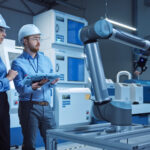Why it Matters
Automation is far from reaching its full potential in manufacturing, offering significant opportunities for labor efficiency and cost reduction.

The Big Picture
New technologies are revolutionizing the manufacturing landscape. A recent comprehensive study from McKinsey across 46 countries reveals that only 64% of manufacturing-related activities have been automated as of 2015. This represents $2.7 trillion of $5.1 trillion in labor costs. McKinsey’s research emphasizes that manufacturing lags behind only accommodation and food services in automation potential.
Emerging technologies like AI and advanced robotics are breaking barriers:
- AI offers capabilities beyond human skills, such as lip-reading accuracy.
- Advanced robots can be trained by frontline staff for tasks previously deemed too complex for machines.
By the Numbers
- $2.7 trillion of $5.1 trillion labor costs are automatable.
- 87% of hours in production occupations in manufacturing are automatable.
- 45% of working hours in other manufacturing roles, like engineering and maintenance, can be automated.
More Details
When dissecting the manufacturing subsectors, the study noticed remarkable variations in automation potential. The labor costs in these subsectors also vary significantly:
- Low-skilled Labor: Apparel, food, and beverages exhibit up to 82% automation potential, emphasizing their susceptibility due to the predominance of repetitive, low-skilled activities.
- Medium-skilled Labor: Sectors like furniture, basic materials, and chemicals show around 70% automation potential.
- High-skilled Labor: Advanced fields like aerospace and defense have about 52% automation potential, dictated partly by the complexity and skill level required.
Additionally, automation is not solely about labor substitution; it offers multifaceted advantages like quality improvement, throughput increase, and error minimization. Therefore, the decision to automate should be a well-calibrated strategy focused on reducing the total cost of operations.

Regulatory and social acceptance also play a pivotal role. For example, labor abundance and low costs in countries like India could serve as decisive factors against automation, or at least moderate its degree. Yet, even these countries can’t ignore the impending wave of automation, particularly as the costs of automation solutions continue to fall.
Go Deeper
- Thia.IO article on the Top 12 Use Cases for AI in Manufacturing Read More
- McKinsey’s Automation Potential by Sector: Offers deep insights into automation possibilities across industries. Read more
- AI in Manufacturing: An academic paper detailing the role and advancement of AI in the manufacturing sector. Read more
- Robotic Process Automation: A report by Deloitte that discusses the maturity and future of RPA technologies. Read more
- Impact of Automation in Developing Countries: Explore this research paper that elaborates the economic implications of automation in countries like India and China. Read more
- Automation Strategy in Manufacturing: A guide by BCG explaining how to develop an effective automation strategy in manufacturing. Read more

Experienced Machine Learning, Artificial Intelligence, Data Strategy, Information Technology, and Shared Services Executive
Things that matter:
• five largest ML models created at P&G, with over 10,000 pipeline runs/year
• initiated and operated THE data labeling platform and services for ML at P&G, with 300+ projects and millions of annotations on the platform
• Generative AI strategy for the Global Business Units Shared Services for the Brand, R&D, Manufacturing, Supply Chain, Master Data + eComm functions
• Product Management leadership for enterprise-wide Cloud applications combining data and AI
Education
Harvard Business School Executive Education: Artificial Intelligence (Competing in the Age of AI).
Northwestern University: Executive Strategies to Unlock Enterprise Value in Artificial Intelligence
University of Bucharest: Master of Computer Science from the Faculty of Mathematics
CIIM – Master of Business Administration (MBA) with a focus on Finance
Key Certifications:
AWS Certified Machine Learning – Specialty
Azure ML Artificial Intelligence Certification
Data Camp Certified Data Scientist (Python Track)












